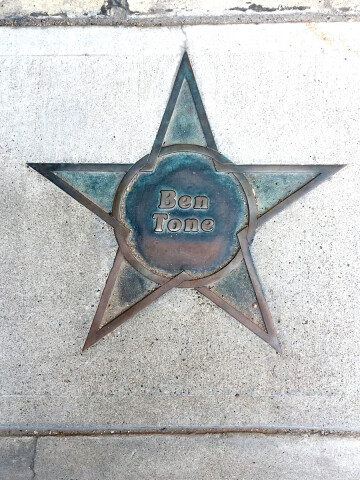Theatre Culture in Bozeman
Kevin Brustuen | Wednesday Jul. 1st, 2020
Gary Cooper, Hollywood star of the 1940s and 50s born in Helena and former student at Montana State College (today’s MSU), is enshrined in Bozeman’s history with a star embedded in the sidewalk near the Rialto Theatre in downtown Bozeman. Across the street in front of The Ellen Theatre, is another name, equally famous in Bozeman acting circles—Ben Tone. Cooper’s and Tone’s copper-plated names embedded in Bozeman’s downtown sidewalks accompany other names of well-known local performers. I often find myself thinking about why and how Bozeman has become such a theatre town. Involved in the theatre world myself, I work with actors, stage managers, design crews, and others involved in putting these shows on stage. Having very recently helped Gretchen Minton publish a book about the history of Shakespeare in Montana, I’ve also come to realize the importance of theatre and drama in Montana. Musing upon these things, a question arises: Who are the people who have been so influential in creating this culture of theatre in southwestern Montana?
It seems there are several threads that came together starting in the post-World War II timeframe: the recreating of Montana’s territorial capitol (Virginia City) by Charles Bovey, the founding of Montana Shakespeare in the Parks, and the emergence of the Montana State University drama department as a respected theatre education department.
Charles Bovey, son of a wealthy Minnesota flour mill owner, moved to Montana in 1926. He began collecting old pioneer-era buildings and other antiques across the state and moving them to Virginia City in 1944. In 1947, he hired Larry and Dori Barsness, originally from Lewistown but active in west-coast theatre, to provide musical entertainment for tourists who were coming to visit Bovey’s historical Virginia City. The Barsnesses proved very popular, and Bovey asked them to return and recreate 1860s-era mining town entertainment in the Virginia City opera house and saloon. Barsness quickly hired his friend Ben Tone from Oregon, and Larry, Dori, and Ben created the Virginia City Players and began performing shows in the summer tourist season at the Bale of Hay Saloon. Inspired by the Barsnesses, the Virginia City Players soon began touring small towns around Montana and Idaho during the winter, the off-season for tourism in Virginia City. Barsness’ lead in creating and touring acting companies caused many people in the ’50s and ’60s to call him “the founding father of Montana summer theater” due to his influence in the founding of the Polson City Players, Fort Peck Playhouse, and the Bigfork Summer Playhouse.
In 1960, the Department of Theatre Arts at Montana State College hired Ben Tone to join other drama faculty, which eventually included Bruce Jacobsen and Joseph Fitch. Tone was a powerful influence not only in the Virginia City Players and the drama department at Montana State University, but also in bringing university performances to the Bozeman public. Many Bozemanites still remember attending performances at the Procrastinator Theatre on campus, as well as at “The Loft Theatre,” upstairs in the Red Barn (today’s Feed Café). The success of the Dramatic Arts program began to attract out-of-state students to Bozeman to take classes from Tone, Jacobsen, and Fitch, as well as bringing young actors into the nascent theater culture of southwest Montana. John Hosking, for example, came to Montana to perform with Shakespeare in the Parks in 1973, and with the Virginia City Players from 1972 until 1981, when he co-founded the Vigilante Theatre Company in Bozeman with Rhonda Smith. Hosking performed with the Vigilante Theatre Company until 2013. He continues to perform on Bozeman stages and create and perform his original music.
Tone’s experience in touring and performing with Larry Barsness seems to be influential in his colleague Bruce Jacobsen’s design for Montana Shakespeare in the Parks (MSIP). Jacobson founded MSIP in 1973 with 14 actors composed of students and faculty members such as English professor Jerry Coffey, performing scenes from four or five Shakespeare plays in Bozeman and several nearby communities. The pilot season was successful, and in 1974 Jacobsen turned this into a real tour and extended performances to four weeks.
Joel Jahnke was hired in 1973 as a designer and technical director for MSU’s Theatre Arts Department. In 1980, Jahnke became Artistic Director for MSIP and expanded the program, hiring out-of-state actors, especially from Chicago. Jahnke expanded the program from a small university tour that performed in 22 communities in Montana into a tour that offered 75 summer performances across five states in 59 communities, a fall show reaching 44 high schools in four states, and a spring show aimed for elementary students in more than 40 communities in rural Montana, Idaho, and Wyoming. Jahnke did more than just stage plays in underserved communities—he also mentored countless actors who came to Bozeman from across the country, creating a belief in actors that they really could have a career in theatre.
Today’s Bozeman theatre scene still reflects the heritage of these 20th-century drama faculty and actors. The current president of Bozeman Actors Theatre is Gordon Carpenter, who came to study drama at MSU from New York City in 1980 because of the reputation of the Dramatic Arts department. Will Dickerson, Rhonda Smith, Tom Morris, John Hosking, Susan Miller, Tonya Andrews and Mark Kuntz are just a few of the BAT actors who have come through the MSU/Shakespeare in the Parks programs and continue to act on Bozeman stages.
There are other “inheritors” of these pioneers of the Bozeman theatre scene. The Children’s Shakespeare Society, founded by Amy Devlin, is an example. Devlin grew up in the front row of the Virginia City Players’ Olio shows and went from that to Shakespeare in the Parks’ Duck Pond performances every year. Her experience growing up with these actors, faculty, and performances inspired her to found the Children’s Shakespeare Society, which stages several Shakespearean plays each year. Devlin also created the Christmas Radio show, performed at the Reynolds Recital Hall at MSU around Christmas time. Written and directed by MSIP and Virginia City alums Doug MacIntrye and Maggie Peterson, the Radio Show stars MSIP alums such as John Hosking, Rhonda Smith, and Tom Morris.
At the end of the day, I wonder whether there is something else in the culture of this area that has brought these people together in the first place. There is the beauty and closeness of the mountains around here of course. But there is also something else I think of that is perhaps equally important. Bozeman has been a small community where the connection of the people is palpable. I think about the 1960s when the town was only a fraction of the size it is now, and yet there were people living and working here like Robert Persig, who wrote “Zen and the Art of Motorcycle Maintenance.” The community also included Robert and Gennie Deweese – famous artists who lived up Cottonwood Canyon and held impromptu get-togethers which included creative people from all walks of life. There were a few actors already, like Peter Fonda, who would show up in local bars and play guitar for the fun of it. In the late 1960s, Montana State University began an effort to become a Carnegie One research institution, bringing more researchers into the area. It seems all this mixing of experiences, thoughts, creativity in so many different fields may hold another key to the reason why Bozeman is filled with so many creative people: It is a small place where no one is more than one or two degrees of separation from anyone else, and thus the creative juices can flow.
And perhaps that is what makes Bozeman such a wonderful place to live, play, and especially to create.
| Tweet |
